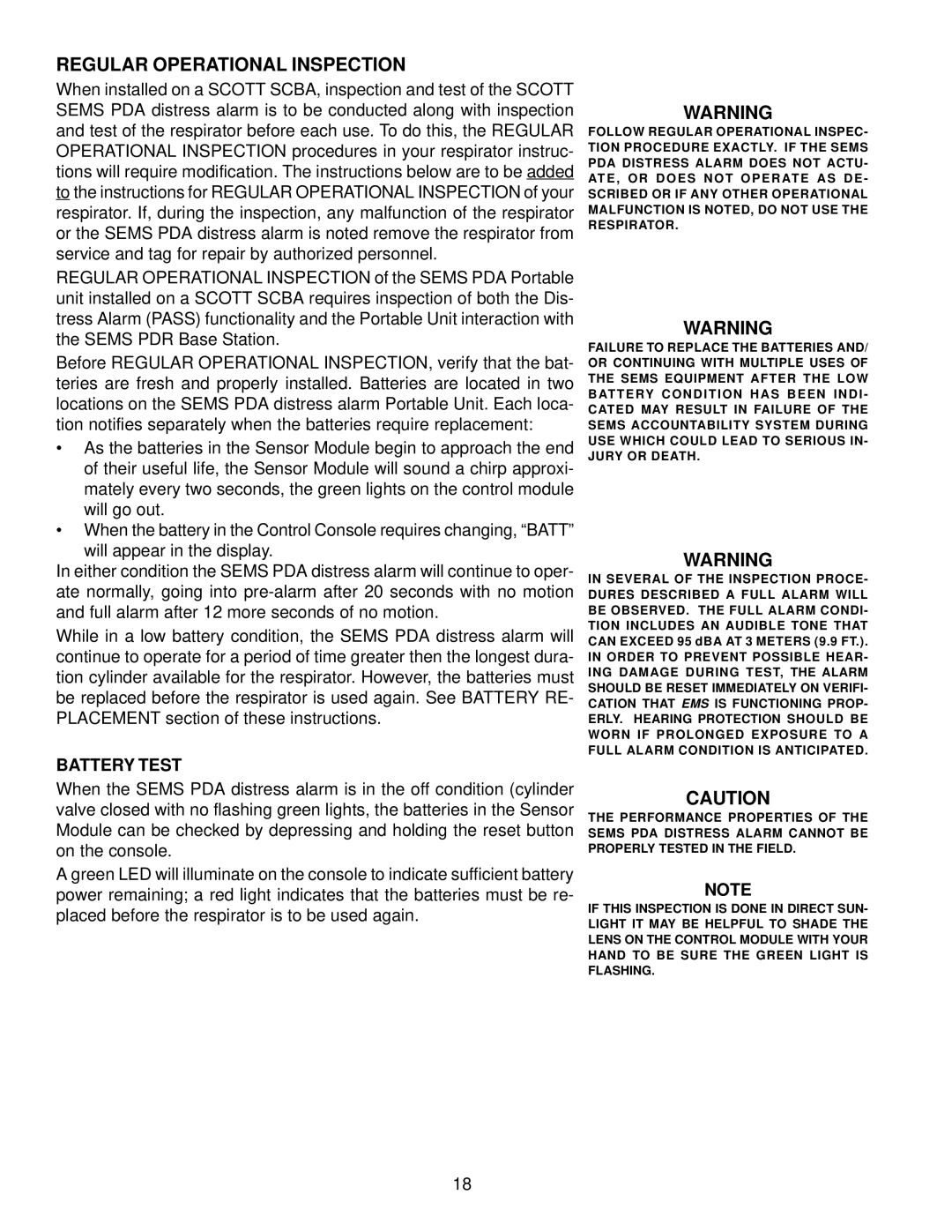REGULAR OPERATIONAL INSPECTION
When installed on a SCOTT SCBA, inspection and test of the SCOTT SEMS PDA distress alarm is to be conducted along with inspection and test of the respirator before each use. To do this, the REGULAR OPERATIONAL INSPECTION procedures in your respirator instruc- tions will require modification. The instructions below are to be added to the instructions for REGULAR OPERATIONAL INSPECTION of your respirator. If, during the inspection, any malfunction of the respirator or the SEMS PDA distress alarm is noted remove the respirator from service and tag for repair by authorized personnel.
REGULAR OPERATIONAL INSPECTION of the SEMS PDA Portable unit installed on a SCOTT SCBA requires inspection of both the Dis- tress Alarm (PASS) functionality and the Portable Unit interaction with the SEMS PDR Base Station.
Before REGULAR OPERATIONAL INSPECTION, verify that the bat- teries are fresh and properly installed. Batteries are located in two locations on the SEMS PDA distress alarm Portable Unit. Each loca- tion notifies separately when the batteries require replacement:
•As the batteries in the Sensor Module begin to approach the end of their useful life, the Sensor Module will sound a chirp approxi- mately every two seconds, the green lights on the control module will go out.
•When the battery in the Control Console requires changing, “BATT” will appear in the display.
In either condition the SEMS PDA distress alarm will continue to oper- ate normally, going into
While in a low battery condition, the SEMS PDA distress alarm will continue to operate for a period of time greater then the longest dura- tion cylinder available for the respirator. However, the batteries must be replaced before the respirator is used again. See BATTERY RE- PLACEMENT section of these instructions.
BATTERY TEST
When the SEMS PDA distress alarm is in the off condition (cylinder valve closed with no flashing green lights, the batteries in the Sensor Module can be checked by depressing and holding the reset button on the console.
A green LED will illuminate on the console to indicate sufficient battery power remaining; a red light indicates that the batteries must be re- placed before the respirator is to be used again.
WARNING
FOLLOW REGULAR OPERATIONAL INSPEC- TION PROCEDURE EXACTLY. IF THE SEMS PDA DISTRESS ALARM DOES NOT ACTU- AT E , O R D O E S N O T O P E R AT E A S D E - SCRIBED OR IF ANY OTHER OPERATIONAL MALFUNCTION IS NOTED, DO NOT USE THE RESPIRATOR.
WARNING
FAILURE TO REPLACE THE BATTERIES AND/ OR CONTINUING WITH MULTIPLE USES OF THE SEMS EQUIPMENT AFTER THE LOW B AT T E RY C O N D I T I O N H A S B E E N I N D I - CATED MAY RESULT IN FAILURE OF THE SEMS ACCOUNTABILITY SYSTEM DURING USE WHICH COULD LEAD TO SERIOUS IN- JURY OR DEATH.
WARNING
IN SEVERAL OF THE INSPECTION PROCE- DURES DESCRIBED A FULL ALARM WILL BE OBSERVED. THE FULL ALARM CONDI- TION INCLUDES AN AUDIBLE TONE THAT CAN EXCEED 95 dBA AT 3 METERS (9.9 FT.).
IN ORDER TO PREVENT POSSIBLE HEAR- ING DAMAGE DURING TEST, THE ALARM SHOULD BE RESET IMMEDIATELY ON VERIFI- CATION THAT EMS IS FUNCTIONING PROP- ERLY. HEARING PROTECTION SHOULD BE WORN IF PROLONGED EXPOSURE TO A FULL ALARM CONDITION IS ANTICIPATED.
CAUTION
THE PERFORMANCE PROPERTIES OF THE SEMS PDA DISTRESS ALARM CANNOT BE PROPERLY TESTED IN THE FIELD.
NOTE
IF THIS INSPECTION IS DONE IN DIRECT SUN- LIGHT IT MAY BE HELPFUL TO SHADE THE LENS ON THE CONTROL MODULE WITH YOUR HAND TO BE SURE THE GREEN LIGHT IS FLASHING.
18
